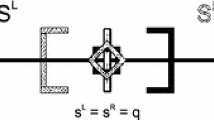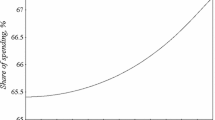Abstract
Discrete Plant-Location Decisions in an Applied General-Equilibrium Model of Trade Liberalization. - This paper makes a first step toward a more realistic approach to increasing-returns trade models in which firms face discrete choices about the numbers and locations of their plants. The model is applied to the North American auto industry in the NAFTA context. Results include: (1) production appears to be excessively geographically diversified initially; (2) autos are produced in fewer locations as trade barriers are lowered; (3) a “non-monotonicity“ case is produced in which a plant is first closed and then reopened as trade barriers are progressively lowered; (4) an example of the misleading nature of marginalist analysis is presented in which plants in Canada and Mexico increase production when locations are fixed but close down when locations are endogenous and optimized.
Zusammenfassung
Diskrete Entscheidungen über Produktionsstandorte in einem auf die Handelsliberalisierung angewandten Modell des allgemeinen Gleichgewichts. -Dieser Aufsatz ist ein erster Schritt in Richtung auf eine realistischere Betrachtungsweise, bei der Firmen diskrete Entscheidungen über Zahl und Standort ihrer Betriebe zu treffen haben. Das Modell wird angewandt auf die Automobilindustrie im Rahmen der NAFTA. Es ergeben sich folgende Resultate: (1) Die Produktion ist anfangs geographisch sehr stark diversifiziert; (2) die Zahl der Produktionsstandorte für Automobile geht zurück, wenn die Handelsbarrieren abgebaut werden; (3) es entsteht ein “nicht-monotoner” Fall, in dem ein Betrieb zunächst geschlossen und dann, wenn die Handelsschranken nach und nach gesenkt werden, wieder eröffnet wird; (4) Betriebe in Kanada und Mexiko erhöhen die Produktion, wenn die Standorte fixiert sind, werden aber geschlossen, wenn die Standorte endogen festgelegt und optimiert werden.
Similar content being viewed by others
References
Brander, James, Barbara Spencer, “Export Subsidies and International Market Share Rivalry.”Journal of International Economics, Vol. 18, 1985, pp. 83–100.
Carstens, Agustin C., Roberto S.E. Escalante,Prices in the Mexican Automobile Sector 1974–1986: A Hedonic Analysis. Unpublished working paper, University of Mexico. Mexico City 1987.
Helpman, Elhanan, “International Trade in the Presence of Product Differentiation, Economies of Scale and Monopolistic Competition.”Journal of International Economics, Vol. 11, 1981, pp. 304–340.
-, Paul Krugman,Market Structure and Foreign Trade. Cambridge, Mass., 1985.
Horstmann, Ignatius J., James R. Markusen, “Up the Average Cost Curve: Inefficient Entry and the New Protectionism.”Journal of International Economics, Vol. 20, 1986, pp. 225–248.
Kehoe, Timothy, Jaime Serra-Puche, “A Computational General Equilibrium Model with Endogenous Unemployment: An Analysis of the 1980 Fiscal Reform in Mexico.”Journal of Public Economics, Vol. 22, 1983, pp. 1–26.
Lopez-de-Silanes, Florencio, James R. Markusen, Thomas F. Rutherford [1994a], “Complementarity and Increasing Returns in Intermediate Inputs.”Journal of Development Economics, 1994, forthcoming.
-, -, -[1994b], “The Auto Industry and the North American Free-Trade Agreement: Employment, Production and Welfare Effects.” In: Clint Shields, Joseph Francois (Eds.),Economy-Wide Modeling of the Economic Implications of a FTA with Mexico and a NAFTA with Canada and Mexico. London 1994, forthcoming.
Markusen, James R., “Trade and the Gains from Trade with Imperfect Competition.”Journal of International Economics, Vol. 11, 1981, pp. 531–551.
-,Thomas F. Rutherford, Linda Hunter (1993), “Trade Liberalization in a Multinational-Dominated Industry.” Under revision for theJournal of International Economics.
Motor Vehicles Manufacturers Association of the US,World Motor Vehicle Data. Detroit, Mich., 1990.
Spencer, Barbara, James Brander, “International R&D Rivalry and Industrial Strategy.”The Review of Economic Studies, Vol. 50, 1983, pp. 707–722.
Scarf, Herbert, “Mathematical Programming and Economic Theory.”Operations Research, Vol. 38, 1990, pp. 377–385.
Schmitt, Nicholas,Endogenous Market Structure with Trade in Differentiated Products: The Two-Country Two-Firm Case. Simon Fraser University Working Paper. Van-couver 1993.
Toder, Eric J., “The Shape of Automobile Cost Functions.” In: Eric J. Toder (Ed.),Trade Policy and the US Automobile Industry. New York 1976, pp. 129–143.
Venabies, Anthony J., “Trade and Trade Policy with Imperfect Competition: The Case of Identical Products and Free Entry.”Journal of International Economics, Vol. 19, 1985, pp. 1–20.




